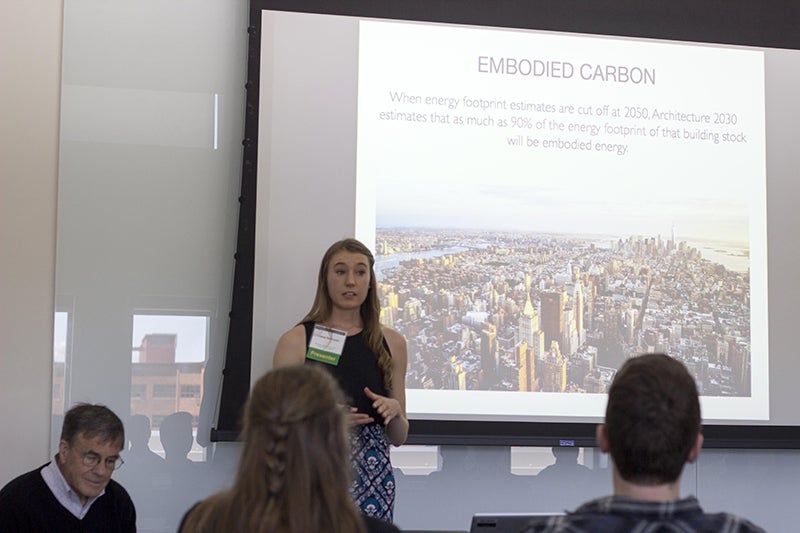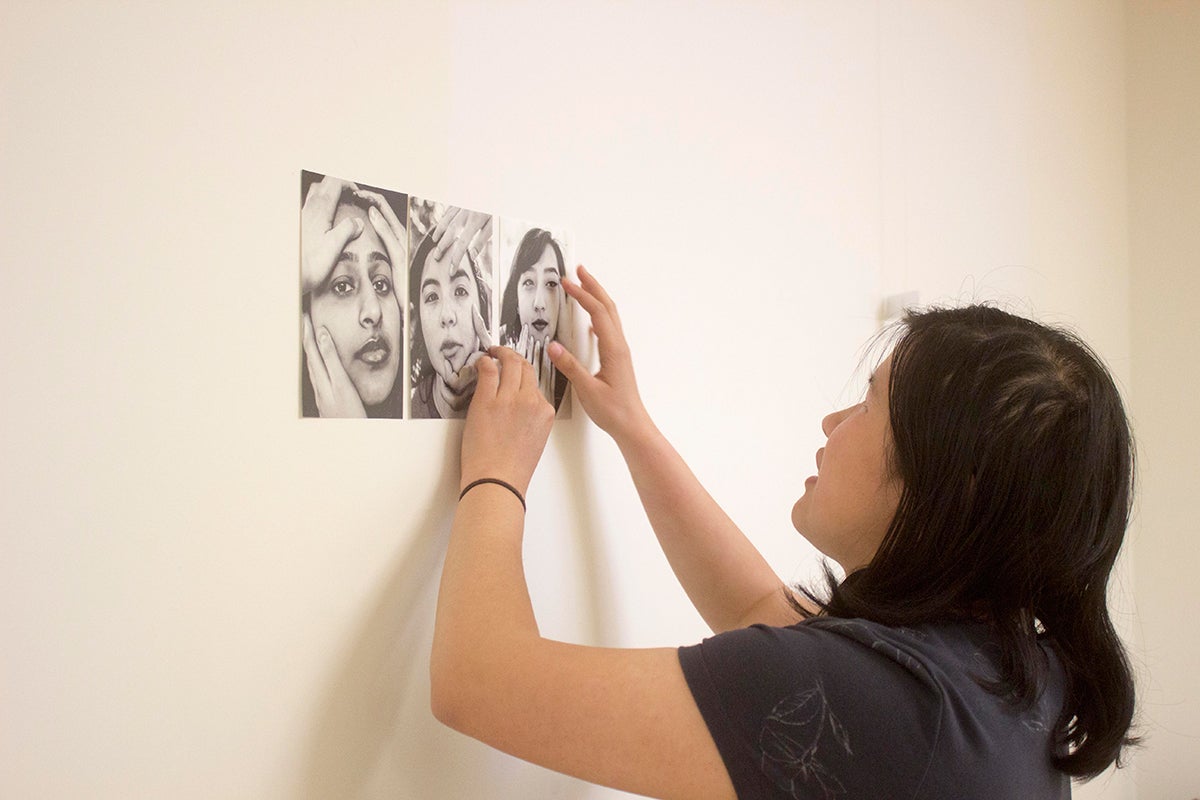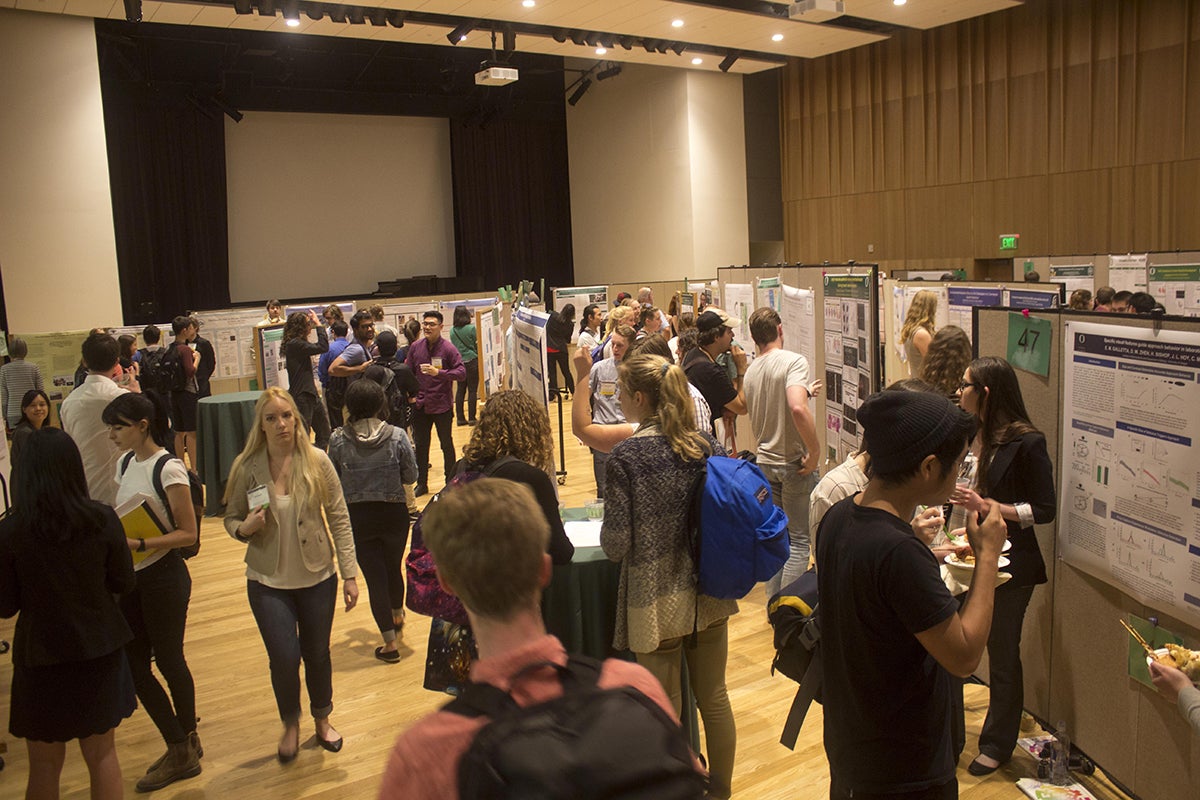President Trump’s Cabinet, a fogged-up windshield, and an artwork made for an Oscar Wilde play were among the unique sources of inspiration for A&AA student projects at the 2017 Undergraduate Research Symposium held in the Erb Memorial Union.

Above: UO architecture student Lindsay Rasmussen presents her research “Accounting for Embodied Carbon in High Performance Design” on Thursday, May 18 as part of the 2017 Undergraduate Research Symposium. Photo by Emerson Malone.
Their research endeavors included:
• Renee Dobre, Simone O’Halloran, Robbyn Wallis (all architecture), “Window Water Shield.” Faculty mentor: Alison Kwok
This research by second-year architecture students aims to conserve energy caused by the “misplaced vapor barriers” of vehicles that can fog windshields and exacerbate driving conditions.
The research was inspired during an ARCH 491 “Environmental Control Systems” course taught by architecture Professor Alison Kwok. Although the class typically evaluates buildings, Kwok said, “Using a car is pretty cool because it's kind of a microcosm of what a building could be.”
Dobre said the idea came while she was drinking from a cold cup that began to bead with condensation on the outside.
“It made me think of how frustrating it is when you have to drive somewhere and wait 5 to 10 minutes to defrost your windows,” said Dobre. “A window water shield is a barrier that you place in the interior of your car to prevent condensation from building up overnight.”
• Emily Fagan, PPPM, “Changing Perspectives in Today's America.” Faculty mentor: Jessica Swanson
During winter 2017, Emily Fagan was enrolled in AAA 199 “Special Studies: Create Change,” taught by art Senior Instructor Jessica Swanson as part of the Common Reading Signature Seminars. Fagan said the course, in which students discussed the social issues addressed in Ta-Nehisi Coates’s book Between the World and Me, inspired her to explore land use.
“I took this as an opportunity to learn more about how National Park Service land is used and how it is threatened by powerful individuals,” she said. The President Trump administration—particularly his Cabinet appointees who deny the science behind climate change and deprioritize the value of the National Park Service—were foundational to her research, she said.
“My goal is not to encourage every American to oppose President Trump,” she said, “but rather to encourage that National Park land and all open spaces be valued, maintained, and cared about by each person.”
• Yimeng He (art history), “The Orient Is No Longer an Unknown World: Confusion and Fear in Aubrey Beardsley’s The Peacock Skirt.” Faculty mentors: Joyce Cheng, Akiko Walley
Aubrey Beardsley created the 1893 artwork The Peacock Skirt for Oscar Wilde’s play “Salome.” Yimeng He’s research analyzes the artwork through a method that views Beardsley, a British artist, as imitating an East Asian, in particular Japanese, style. Previous critics of The Peacock Skirt often tied it to the social environment of Britain, where Beardsley resided, instead of considering its global implications.
Yimeng He’s research stemmed from an assignment in ARH 300: “Critical Approaches to Art Historical Study,” taught by Joyce Cheng, associate professor in the Department of the History of Art and Architecture.

Above: Pre-journalism student Kezia Setyawan, a student in fall 2016 term’s First-Year Interest Group (FIG) course AAD 199: “Portable Life Museum,” sets up her photo project for the 2017 Undergraduate Research Symposium on Thursday, May 18. Photo by Emerson Malone.
• Lindsay Rasmussen (architecture), “Accounting for Embodied Carbon in High Performance Design.” Faculty mentor: Alison Kwok
Passive energy buildings typically include a lot of carbon-intensive materials in their architecture. “My research dives into how to reduce the embodied carbon impacts in order to greatly reduce the impact our architecture has on climate change,” Rasmussen said.
Her project focuses on embodied carbon—the amount of fossil-fuel energy required to manufacture and transport all the materials in a building—in passive house design.
This summer, she will present this research at an international conference on Passive Low Energy Architecture (PLEA) in Edinburgh, Scotland.
• Mya Clover-Owens (art), Alisha Martin (art and technology), Kaitlyn McCafferty (art and technology), Kezia Setyawan (pre-journalism, art, art and technology), Cullen Sharp (undeclared), Sydney Stark (art and technology), and Carlie Stroud (art), “Our Bodies, Our Country, Our World. Faculty mentor: Julie Voelker-Morris.

Above: PPPM undergraduate student Emily Fagan (left) and art Senior Instructor Jessica Swanson in front of Fagan’s research poster “Changing Perspectives in Today's America.” Image courtesy of Jessica Swanson.
During a First-Year Interest Group (FIG) course, AAD 199: “Portable Life Museum” in fall 2016, students read Between the World and Me and created artwork to respond to the text’s themes of prejudice, identity, inclusion, and marginalized communities. The project culminated in an exhibition in the Global Scholars Hall.
Julie Voelker-Morris, senior instructor in the Arts and Administration Program, encouraged her students to reprise the exhibition for the symposium. The final product included photography, art, video, and other creative responses from the students.
Setyawan created a photography series featuring Asian-American women.
“I want to be conscious of how [Coates’s] experience is different from my own, but I want to make art applicable to my own experience,” said Setyawan. “It’s an investment to the people and the community I care about.”
• Amy Tubau and Scarlet Weaver (both architecture), “Minimal Surface.” Faculty mentor: Marziah Rajabzadeh
Weaver and Tubau, both third-year architecture students, investigate the effects that architectural geometry has on minimal surface design, which works by using regular geometry to calculate the mean curvature of zero; the curves provided form the surface.
“If you place a wire form [of any shape or geometry] into a pool of liquid soap and begin to pull away, the bubble that forms is a minimal surface,” said Weaver. “Our project focused on developing those curves into physical spaces for people to inhabit.”
By entering specific architectural considerations into programming software, Weaver and Tubau calculated a catalog of shapes, or minimal surface designs. The objective was to establish that setting parameters could achieve any design goal, as opposed to approaching a design conceptually.
“Research-based design is tailored to architects who prefer to work with the left side of their brain than their right,” Weaver said.

Above: Students share their research projects during the 2017 Undergraduate Research Symposium on Thursday, May 18 in the Erb Memorial Union Ballroom. Photo by Emerson Malone.
